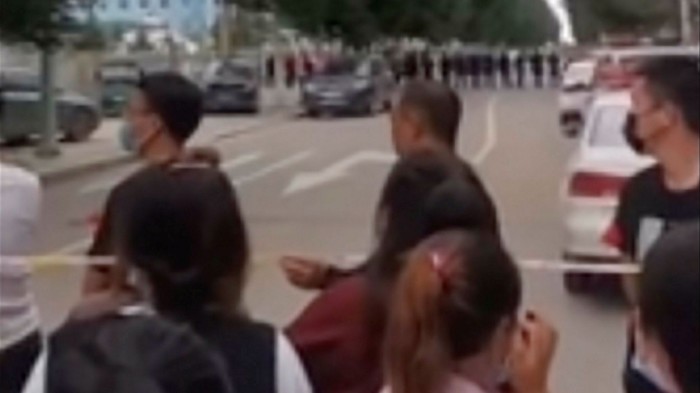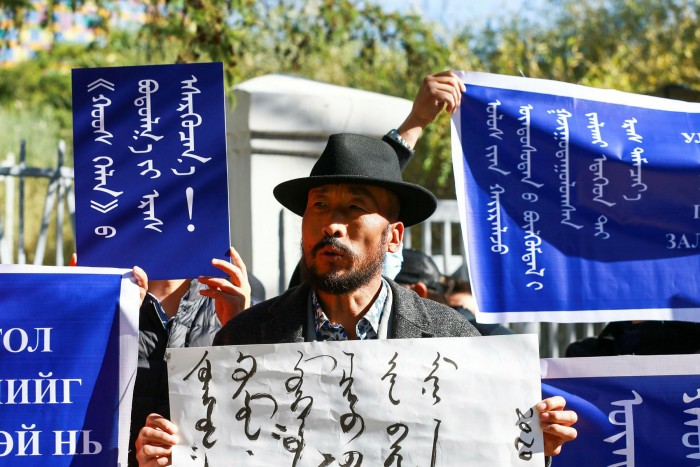Authorities quash Inner Mongolia protests

Simply sign up to the Chinese politics & policy myFT Digest -- delivered directly to your inbox.
Students are returning to school following weeks of fierce demonstrations in Inner Mongolia, after a public manhunt and the threat of parents being fired from their jobs quashed protests against curbs on local-language teaching.
Some of the most widespread mass resistance from ethnic Mongol communities in almost a decade erupted late last month after Beijing moved to use standardised Chinese to teach history, politics and literature in Mongolian-language middle schools.
Tongliao, a city at the eastern end of the resource-rich expanse of grassland, desert and forest that spans much of China’s 2,880-mile border with Mongolia, has been at the centre of the stand-off.
Bu Xiaolin, governor of Inner Mongolia, told teachers on a tour of Tongliao schools last week that adopting the state-written textbooks was a “major political task” that would be beneficial now and into the future.
The policy was formally announced at the end of August, less than a week before the start of term. Mongol parents, teachers and students quickly arranged sit-ins, protests and school boycotts.
Local authorities responded with a propaganda push, a heavy-handed police crackdown and intense pressure on parents to send children back to class.
By September 2, Horqin district police had released wanted lists of 129 protesters suspected of disorderly behaviour. Alongside grainy photos apparently taken by security cameras, a cash reward of Rmb1,000 ($146) was offered and police officers with clipboards checked cars at the toll gates leaving Tongliao.

In the city of Bayan Nur, a reward of Rmb10,000 led to the arrests of four people accused of using WeChat, the messaging app, to spread “fake news” about the textbooks and organise petitions.
Last weekend, in a region to the west of Tongliao, government workers were told that their children would have to attend school on Monday. If they did not, the parents’ pay would be suspended and they would be put under investigation by the party’s anti-graft authorities, according to an image of the order shared by Inner Mongolian residents.
After the Monday deadline, some locations began to announce punishments for cadres who “failed to rectify behaviour after being admonished”.
The government of Sonid Left Banner of Xilin Gol League, a region north-west of Tongliao on the border with Mongolia, announced that the pay of four officials had been suspended and two others were fired. All six were placed under investigation by the local Discipline Inspection Commission, the body responsible for enforcing loyalty to the party.
In Tongliao, the harsh measures appear to have forced the acceptance from some parents.
Last week, students at the Horqin district Mongol middle school had rushed past teachers to break down the front gate and flee campus, according to a video of the incident that was independently verified by witnesses.
By Monday, the gate was back in place, reinforced by a steel red-and-white anti-riot barricade. A handful of students, mostly flanked by parents, returned under the watch of officers who sat in police cars. The only sign of the protests this week were the police cars on patrol and large quantities of barricade tape.
“The students are back in school, [there are] no more complaining parents or students,” said Ms Tong, a teacher who declined to give her full name. “We are officially using the new textbooks.”
Parents who had protested were now reluctant to speak about their earlier complaints. “The problem has been resolved,” one man said in response to the Financial Times, while hurriedly pulling his son towards the school gate.
Some middle school students appeared ambivalent. “Lots of fellow students have not come back, but my parents said we have to go to school,” said one 15-year-old, who was waiting for a friend down the road from the gate.
The police declined to comment.
Under President Xi Jinping, China’s established system of “preferential policies” pledging marginal autonomy for ethnic minorities is being stripped away. Instead, mores assertive policies inspired by thinkers who support a unified, singular and Han-Chinese dominated “state-race” are being adopted in a bid to assimilate ethnic minorities.
But unlike Tibet and Xinjiang, where grievances over perceived discriminatory treatment of ethnic minority communities from Beijing have sparked mass riots, Inner Mongolia has largely avoided violence.
The region has also yet to face blanket surveillance to the same degree as Xinjiang, where new police stations have been built on every block and enforced data collection has become ubiquitous.
But the scale of protests — and the severity of the clampdown — raise the prospect of a heightened response. Mongols retain a strong sense of ethnic identity and have consistently resisted Beijing’s efforts to meld them into mainstream Han culture.
One herder in the Jarud banner region of Tongliao said he planned to keep his six-year-old son out of school for as long as he could.
“They shouldn’t have done it like this,” said the herder, who declined to be named. “I have no problem with him learning the Han language, but there should have been a discussion. We will teach him ourselves for now.”
Comments